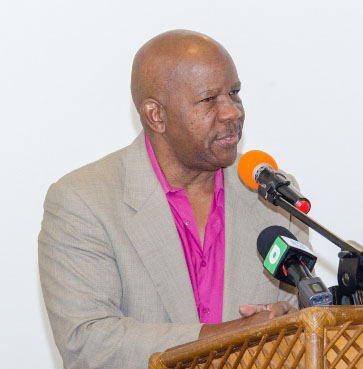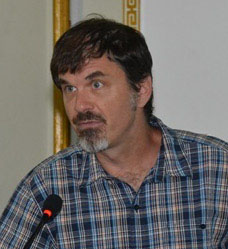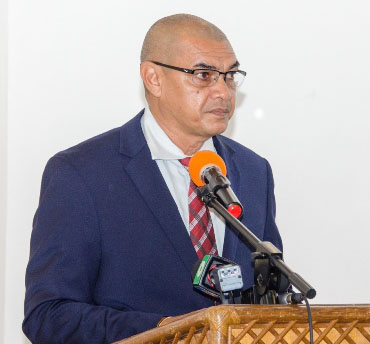The Department of Tourism, within the Ministry of Business, yesterday hosted its first ever Regional Tourism Review Session, where representatives of groups within the respective regions were able to present and speak on what can be done to boost tourist in their areas.
The session, held at the Herdmanston Lodge, was declared open by the Minister of Business Haimraj Rajkumar. The minister told regional representatives and stakeholders at the session that the regional tourism approach will help to develop the unique tourism products that each region has to offer. “The region-led development approach will give each region the opportunity to develop their unique tourism product offering that will attract both local and foreign visitors,” Rajkumar said.
Director General of the Department of Tourism, Donald Sinclair, who was the chairperson of the session, stated that lots of exciting things are happening in tourism in Guyana. Sinclair said that there is a legal basis to regional tourism planning, which is mentioned in Chapter VII of the Constitution. “It states, local government is a vital aspect of democracy and shall be organised so as to involve as many people as possible in the task of managing and developing the communities in which they live,” the Director General said.

He added that as tourism is now the third largest export after gold and rice, people can now with confidence demand respect for the tourism industry, as it is providing revenue for the country along with creating jobs. Sinclair went on to say that the Department of Tourism has devised a strategy to decentralize tourism planning, which will bring municipalities and sub-districts into the planning of tourism and tourism activities. He added that one of the main things that the department has done so far in their visits to the various regions, was to provide them with connections to organisations that would be able to assist them in whatever way necessary.
Brian Mullis, the Director of the Guyana Tourism Authority (GTA), told the gathering that the GTA is committed to supporting and empowering Guyana’s tourism industry and communities. He continued by saying that Guyana has experienced an overall growth in tourism in 2019. “We’ve already experienced a 9.2% growth overall in tourism in 2019. With the current growth rate it’s likely we could easily hit 500,000 visitors by 2025. That’s almost double what it was in 2017,” Mullis said. He added that with the growth of the sector, there is an increased need for collaboration, products and improving capacity building efforts.

Throughout the session, the regional tourism groups were given an opportunity to speak on the accomplishments they have had with tourism within their regions, the challenges they face, their plans for the upcoming tourism awareness month in November, 2019 and even future projects for 2020. Some regions had multiple tourism groups which spoke about different villages and parts of their respective region.
Hot spots
One of the representatives from Region One (Barima-Waini), Ammon Thom, from the Mabaruma Tourism Working Group, told persons present at the session about the Barima-Waini Adventure Tours. He stated that the group has so far elected committee members, and identified the hot spots for tourists in the region, which include Shell Beach, Hosororo Falls, Barima Bridge and the White Water Creek, among many other sites.
The Santa Rosa Tourism Committee was also able to present on their plans for their village, specifically as a tourist hub. Secretary of the committee, Marcus Atkinson, stated that the committee was only recently formed and they would love to promote activities such as canoeing, fishing, wildlife spotting, among others. The secretary told stakeholders that they intend to host the Moruca Expo, which would include a crab catching competition, which has been a part of the culture in the village for many years.
From the Region Two Tourism Association, Shalini Sukhdeo stated that their association too has only recently been formed. Sukhdeo said that they have held a number of cleanup campaigns within the region to keep the region clean and free of garbage. The group has plans to host various programmes, including masquerade competitions, along with sports competitions to promote tourism.
The representative from Region Seven’s Regional Tourism Committee stated that they too would have conducted cleanup campaigns around frequent tourist destinations within the area. The group would have also conducted guided tours for students in the area, so as to educate them on the history of the region, specifically Bartica and the frequented tourist sites. The group would like to conduct training in customer service for stakeholders in the tourism sector, and occupational health and safety training for smaller food vendors and salespersons.
Coordinator of ‘Visit Rupununi’, Candace Phillips, who represented Region Nine at the forum, stated that ‘Visit Rupununi’ is an established Regional Destination Management and Marketing Organisation which was established in 2015. Phillips stated that though they would have made significant strides in the development of tourism in the region, there is still more development to be done.
The coordinator stated that they have been in contact with the GTA for their recommendations on how they can improve on the work they have done so far. While the group has been in partnership with various stakeholders for various events that would attract tourists, like the Rupununi Rodeo, they continue to analyse various tourism spots within the region.
Other representatives from tourism groups within all 10 administrative regions presented on their plans and what they would like to see happen in their regions to promote tourism. However, while many groups spoke of the various challenges that they face with promoting tourism in their regions, the challenges were common in most of the regions. Those challenges include the lack of finances, the need for sensitisation among residents in the various areas about tourism, its necessity, importance and the roles that residents themselves can play as it relates to the improvement of regional tourism.
Another challenge was the need for training of persons in the regions to be tour guides. The main challenge, however, which was singled out by the Region Seven representative, was the inclusion of villages and communities in Region Seven which are usually forgotten and overlooked, like the Upper-Mazaruni.
The session ended after panel discussions on what can be done to improve the tourism sector within each region.





